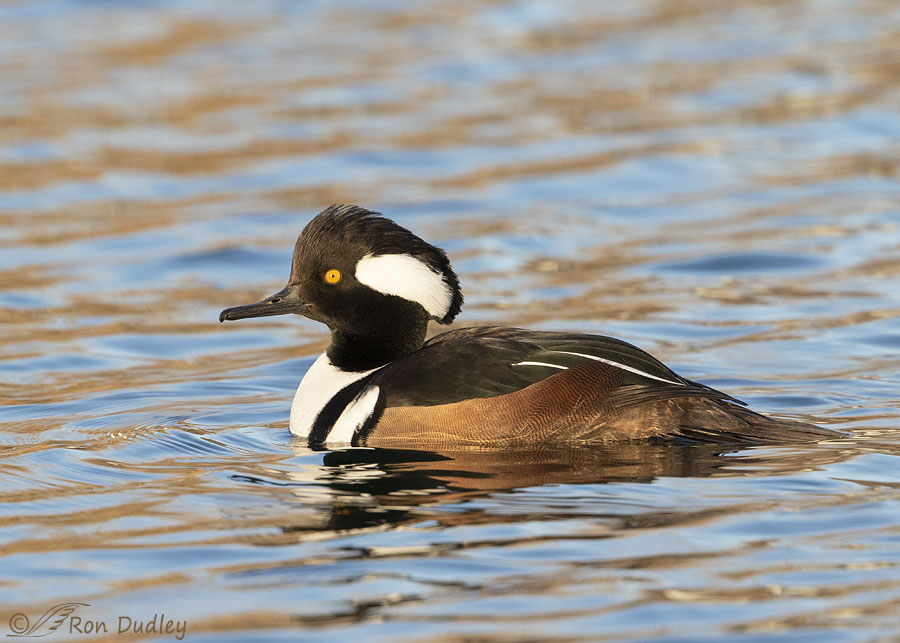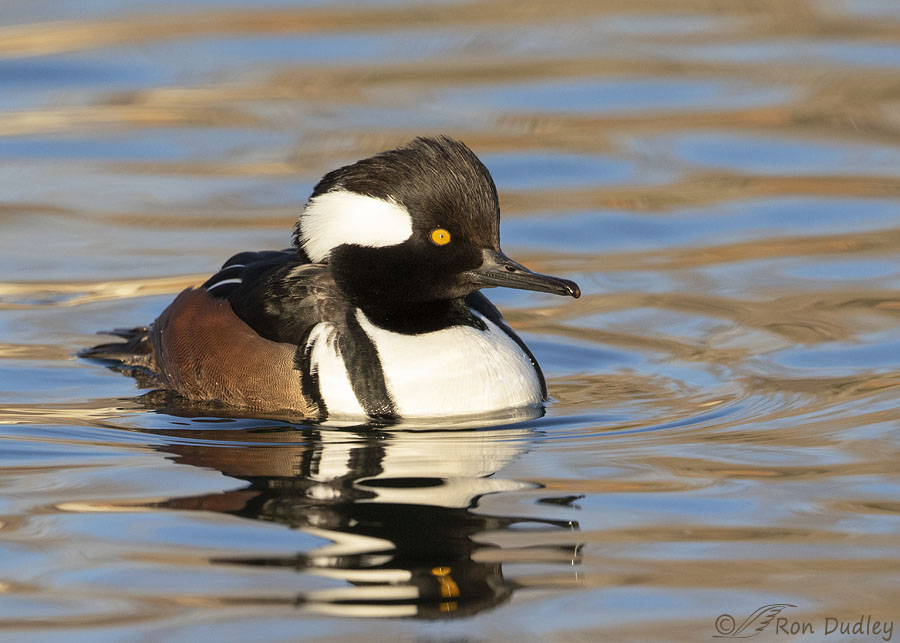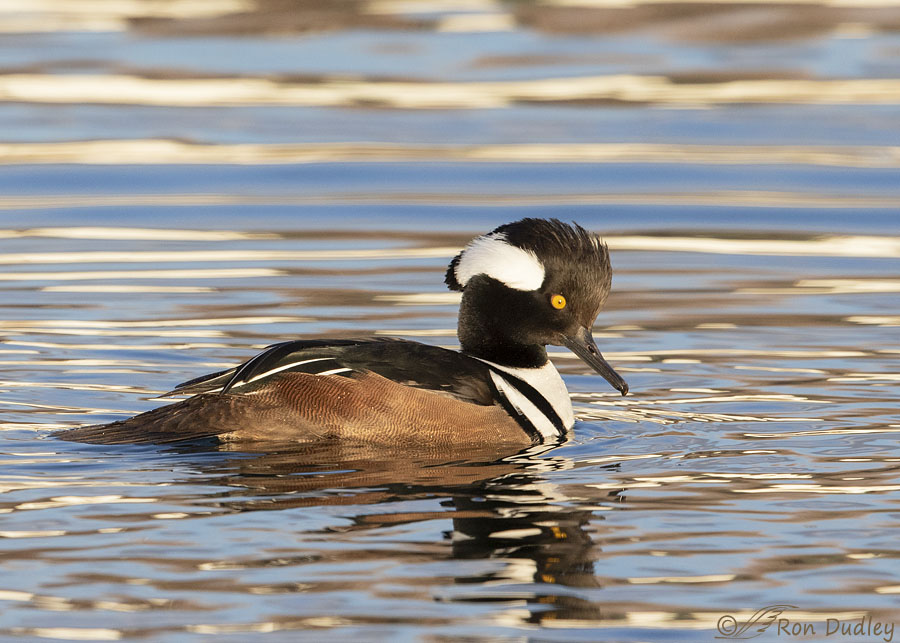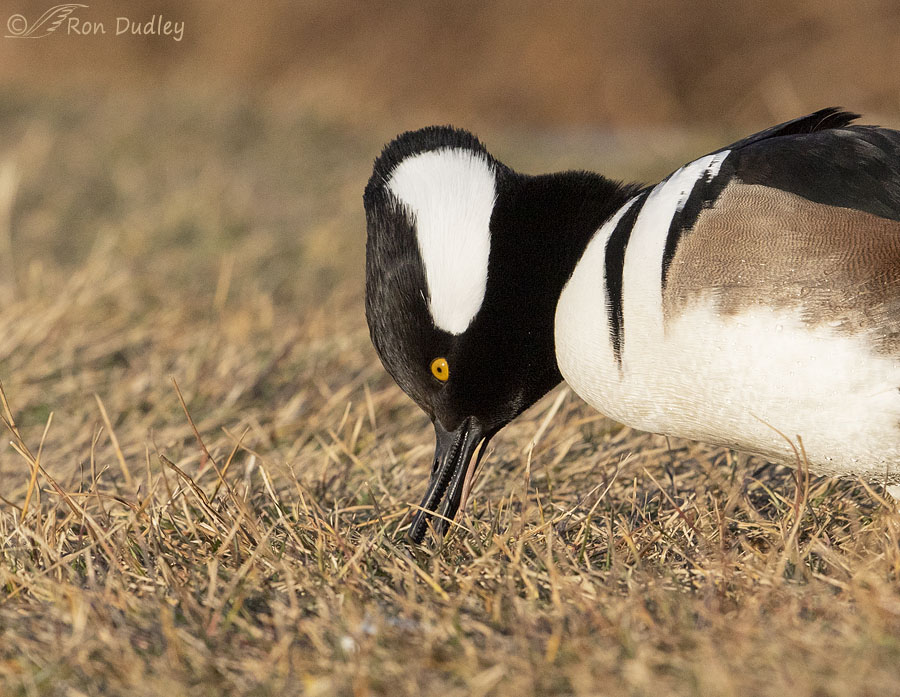Drake Hoodies may be pretty little ducks but their flashy and contrasty colors make them one of the most difficult exposures I’ve ever attempted.

1/1250, f/6.3, ISO 800, Canon 7D Mark II, Canon EF 500mm f/4L IS II USM + EF 1.4 III Extender, not baited, set up or called in
This is the male Hooded Merganser I photographed three days ago. Most of the shots I posted of him previously were taken after he’d come out of the water so I wanted to include a few with him in more typical fresh water habitat. Since these photos were taken just before sunset the warm colors of the reflections in the water are complementary to one of the the dominant colors of the bird.
An unusually high percentage of my photos of him were poorly exposed so they’ll be deleted for that reason. Those whites are really white and the blacks are aggressive photon-suckers so in many of my photos the whites were blown or the blacks had no detail at all. Or both. It was disappointing.

1/1600, f/7.1, ISO 800, Canon 7D Mark II, Canon EF 500mm f/4L IS II USM + EF 1.4 III Extender, not baited, set up or called in
The angle of the merganser to the sun had to be just right for me to manage a decent exposure.

1/1600, f/6.3, ISO 800, Canon 7D Mark II, Canon EF 500mm f/4L IS II USM, not baited, set up or called in
While he was on the water he posed very little but in this shot I like the tilt of his head and the texture we can see in his crest.

1/5000, f/7.1, ISO 800, Canon 7D Mark II, Canon EF 500mm f/4L IS II USM, not baited, set up or called in
In my ignorance I always thought Hooded Mergansers were strict carnivores, eating things like small fish, aquatic insects and crustaceans (crayfish in particular) almost exclusively. But in this heavily cropped shot taken after he came out of the water he appeared to be eating grass or seeds. A little research confirmed that they do eat vegetation occasionally.
This closeup reveals the tiny serrations on his slender bill that allow him to securely capture his more typical and more elusive fish and invertebrate prey.
I’ve looked for this bird since these photos were taken but struck out. Maybe he’s moved on but I’m hoping he was just hiding from me and I’ll have better luck on another day.
Ron


What wonderful pictures! I love the warm light on the water. I think my favorite is the one where he’s posing, for the same reasons you mentioned, and because it provides such a clear look at the beautifully patterned chestnut feathers.
I love these little ducks. Partly for their beauty (including the females, with their windswept hairstyles), but also because the idea of carnivorous ducks amuses me so much – reminds me of Monty Python’s killer rabbit.
Wonderful series Ron, thanks for shRING!
charlotte
Thank you, Charlotte.
Wonderful shots. I like how the goldish hues in the water, blends in with the bird feathers.
Thanks, Jean.
Yet another delightful series and comments. Starting my day here pays dividends in so many, many ways. Education (birds I have not seen/facts I did not know), beauty, humour and delight.
Our swans (probably all swans) have those serrated bills too. Something I found out when down by the lake. We didn’t feed them (though many do) and an aggressive/determined swan nipped at my fingers.
Thank you, EC. Some swans can be extremely aggressive and they have the body size to back it up!
A++!!! And I’ve never given that grade freely. The bird, the water, the light — serenity personified…er…perduckified. I’m impressed by the details in the blacks and whites and especially blown away by the beautiful patterns in the lighter browns.
When I saw the last shot, my first thought was Icthyosaur. Then upon closer inspection I realized I had a pair of trail shoes like that. 😜 I can even see the serrations when I embiggen the first two shots.
Marty, it sounds like you treat grades similarly to how I always did. An “A” has to be legitimately earned, otherwise it has little valid meaning.
I’ve emailed you a tighter crop of those serrations at a higher resolution so you can see them better.
“Marty, it sounds like you treat grades similarly to how I always did. An “A” has to be legitimately earned, otherwise it has little valid meaning.”
This. Exactly. I was generous with my Ds, but you had to EARN an A or B in my class. I had my guarantee at the start of every semester: If you come to class regularly and do the majority of your work with care so that it is complete and mostly correct, you can screw up every test and still pass the class; if you do all that and still flunk, I’ll give you a $100 bill. Never had to give a kid money. 😉
Yay! What a beautiful way to start the day! I’ve only seen the serrations with the help of a spotting scope. Love this series!
Diane, I think that’s the first time I’ve ever seen the serrations although I have seen them in other merganser species.
Excellent shots Ron. You are right about the colors of the water complementing his coloring. Beautiful birds. We have quite a few here every winter in at least two of our lakes. I had no idea what they were the first time I saw them here in Prescott. Had never seen one before. Thanks for the closeup that shows the serrations along his bill. All the photos I have ever taken are with a closed bill.
Thanks, Everett. You’re lucky to have so many of them. I rarely see them in my regular birding spots.
Beautiful! 🙂 Definitely “contrasty” right up there with magpies and similarly colored birds 😉 Glad you were able to pull a few well exposed shot out of it. Noted the serrated bill before reading – a surprise thought it shouldn’t have been…
Judy, that’s the only photo I have that shows those serrations in this species. I’m happy to have it.